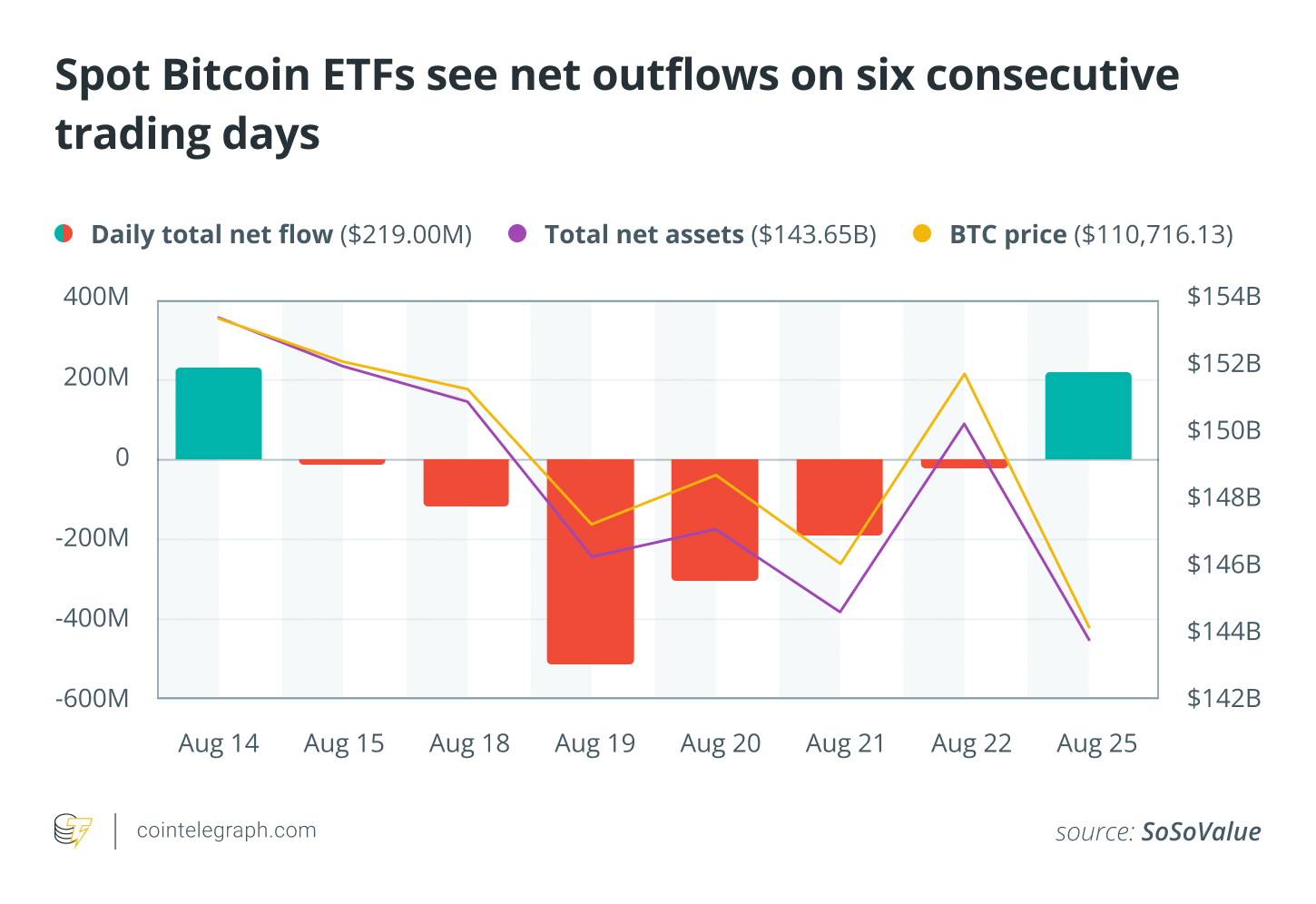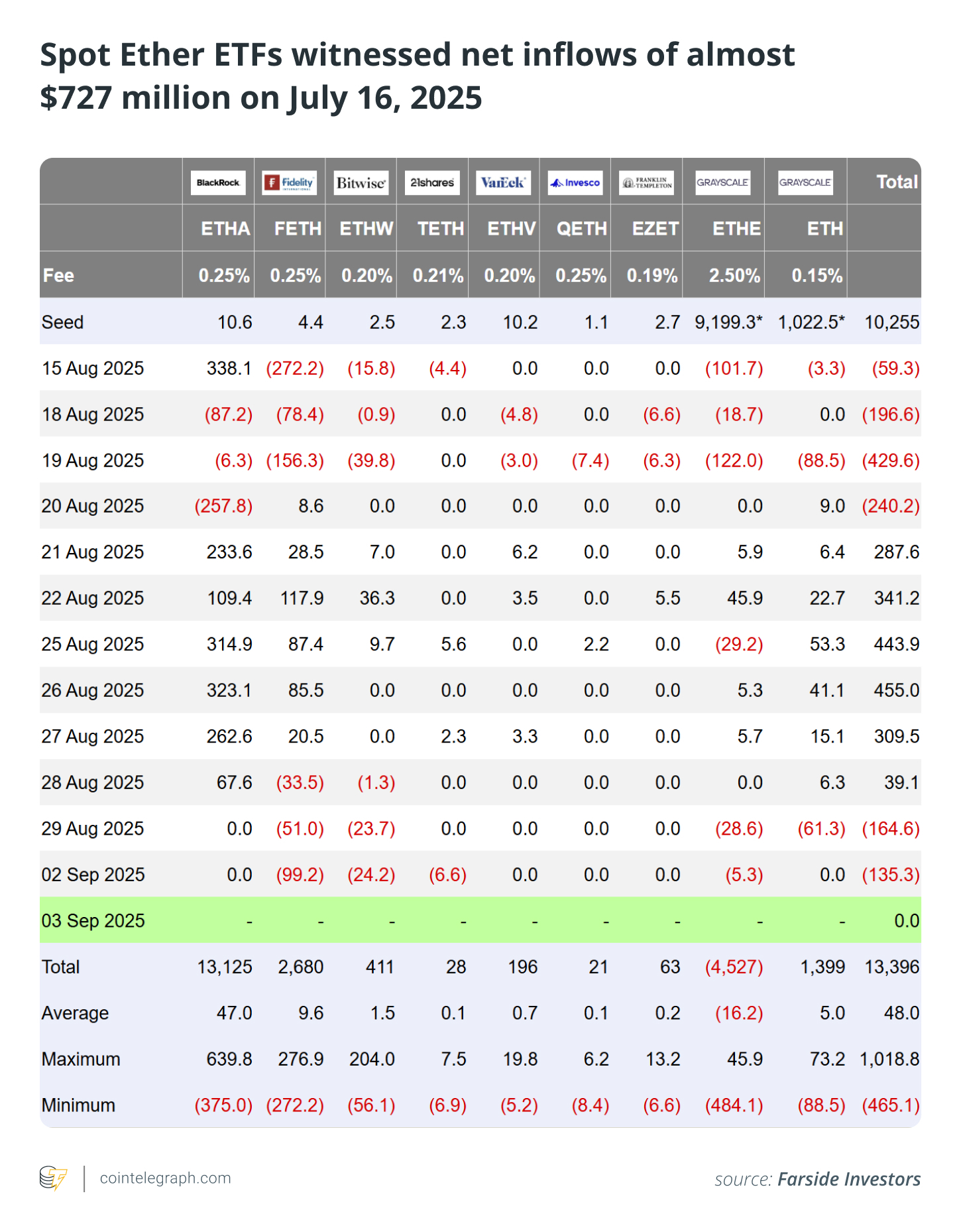
Understanding Ether ETF Inflows and Their Implications for Traders
The Rise of Ether ETFs
In August 2025, Ether (ETH) saw an influx of $3.87 billion as spot exchange-traded funds (ETFs) gained traction, in stark contrast to the $751 million that Bitcoin (BTC) ETFs experienced in outflows. Over time, Ether has proven its value beyond being a standard cryptocurrency. It serves as a foundation for decentralized finance, non-fungible tokens (NFTs), and smart contracts, offering tangible benefits that Bitcoin does not.
The recent introduction of spot Ether ETFs has provided institutional investors with a straightforward route to investing in ETH. As per SoSoValue’s data, Ether ETFs collectively garnered $3.87 billion in net inflows in August 2025.
 Ether ETF Inflows
Ether ETF Inflows
This difference in inflows has rekindled conversations surrounding the potential for Ether to surpass Bitcoin in market capitalization. This trend holds significance for traders as ETF inflows frequently precede important price shifts.
What Are Ether ETFs and Why Do Inflows Matter?
Ether ETFs currently control roughly $28 billion in assets (~5% of ETH’s market cap) and continue to grow as their inflows speed up, even though Bitcoin ETFs are still larger.
To appreciate the implications, it is essential to understand what Ether ETFs are:
- Definition: An Ether ETF is a fund available on stock exchanges, enabling investors to acquire exposure to ETH without direct purchase or storage.
- Spot vs. Futures ETFs: Spot ETFs maintain Ether assets directly, while futures ETFs mirror ETH futures contracts.
- Inflows: The net money entering ETFs. Efficient inflows indicate strong demand and confidence among investors.
Recent statistics (as of late August/early September 2025) underline how this market is evolving:
- BlackRock’s ETHA ETF holds about $16 billion in assets.
- Grayscale’s ETHE manages approximately $4.6 billion.
- Fidelity’s FETH oversees approximately $3.5 billion.
Bitcoin ETFs still outpace Ether ETFs with assets exceeding $100 billion, headed by BlackRock’s IBIT at around $82 billion. Nonetheless, current trends imply that Ether is gaining ground.
Ether Inflows as a Market Indicator
ETF inflows reveal how institutional players are positioning themselves in the market.
Traders should closely observe these metrics, knowing that they often correlate with price movements and liquidity adjustments.
The significance of inflows includes:
- Institutional Sentiment: Increasing inflows indicate that hedge funds, pension funds, and asset managers are optimistic about ETH.
- Liquidity Dynamics: Higher ETF demand pulls ETH off exchanges, decreasing supply and enhancing price upward pressure.
- Historical Precedents: In 2021, ETF inflows rallied to about $7.6 billion, catalyzing Bitcoin’s ascent to new height.
For instance, on July 16, 2025, Ether ETFs logged $726.6 million in single-day inflows, which correlates with ETH testing the $5,000 range before retracing slightly.
 Daily Inflows
Daily Inflows
Late August 2025 also saw US spot Ether ETFs realize their second-largest daily inflow ever at $729 million, shortly after recording an unprecedented $1.02 billion.
Impact of ETF Inflows on Short-Term Price Movements
Ether ETF inflows hold the potential to greatly influence short-term price fluctuations. As billions are funneled into these ETFs, the supply of ETH available on exchanges decreases, leading to upward price movement and also volatility due to market reactions.
Some short-term effects for traders include:
- Price Surges: Inflows often inspire spikes in demand, such as the 40% increase in ETH during July 2025.
- Volatility: After robust inflows, ETH experienced a 4% drop in 24 hours when it failed to maintain a $5,000 price point. Traders should anticipate potential pullbacks.
- Options Market Dynamics: Rising inflows elevate implied volatility, which presents opportunities for options sellers.
Traders should be aware of strategies that include monitoring momentum during inflow spikes and considering exchange reserves for early indications of price patterns.
Long-Term Institutional Integration of Ether ETFs
The emergence of Ether ETFs signals a move towards deeper institutional adoption of cryptocurrency, promoting long-term stability and integration of ETH into global finance systems.
Growth in Corporate Treasury Adoption:
- SharpLink Gaming has added over 800,000 ETH to its treasury.
- ETHZilla has boosted its reserves to exceed 102,000 ETH.
- BitMine Immersion Tech now holds over 1.8 million ETH, claiming the title of the largest publicly traded ETH owner.
Shifting Institutional Sentiment:
- VanEck CEO Jan van Eck referred to ETH as “the Wall Street token,” highlighting its critical role in stablecoin transactions.
- ETH ETFs now constitute over 5% of total ETH market cap, indicating notable mainstream acceptance.
Potential Advantages:
- Improved liquidity and diminished volatility as ETF involvement escalates.
- Introduction of fresh demand from pension funds and insurance companies.
- Enhanced incorporation of ETH into conventional finance frameworks.
Ether’s utility, encompassing more than mere value storage, underlines its appeal as a sustainable institutional asset.
Risks and Challenges for Traders
Despite the promising outlook for Ether ETFs, traders need to stay vigilant about potential risks affecting the market soon.
- Regulatory Uncertainty: Legislative measures like the GENIUS Act and CLARITY Act may clarify crypto rules, yet regulation remains unpredictable. The SEC could rapidly alter its position, potentially affecting ETF approvals.
- Competition with Bitcoin ETFs: Bitcoin ETFs lead the charge with over $100 billion in assets, primarily from BlackRock, which could affect ETH’s momentum.
- Overreliance on ETF Data: Heavy inflows can create bullish expectations, but significant outflows might lead to drastic drops. Traders should consider various indicators before making decisions.
- Volatility in Early Stages: With Ether ETFs still emerging, they may exhibit heightened volatility. Price swings could exceed 10% based on minor news. Effective risk management is essential to navigate this landscape.
Did you know? Ether reached a new record price of $4,945 in August 2025, surpassing its previous high in November 2021 as institutional investment surged.



